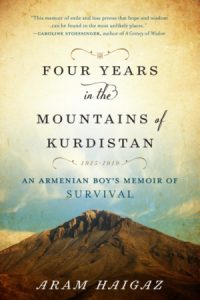The Story Behind the Book
Background
Four Years in the Mountains of Kurdistan tells of four years in the life of Aram Haigaz, who was born in 1900 in the Armenian town of Shabin Karahisar, in the northeastern part of present day Turkey. In 1915, when the story begins, the surge to exterminate the entire Armenian population of Ottoman Turkey was at its peak. The strategy of the Turks was to arrest and kill the men in the villages and then deport the women and children on the pretext of “temporary relocation,” a well-documented prelude to death.
The historically Christian Armenians were considered infidels by their Muslim rulers, and although some survived by converting to Islam, or in other ways, the number of Armenian deaths is generally put at 1.5 million.
Aram Haigaz was fifteen when Shabin Karahisar was attacked, and was with his people as they fought to defend themselves against the Turkish battalions for almost one month, until famine forced their surrender. His brothers, father, other relatives, and most of the townspeople were killed. He and his mother survived and were consigned to a caravan, as those moving herds of humanity were called. Their group consisted of about 350 captives, but there were thousands of such units throughout Turkey, many larger, with the deportees marched without food or shelter to the Syrian and Iranian deserts, to perish en route or be massacred. Such mass expulsions required manpower; the Kurdish tribes, and 30,000 convicts released from jails were among those called upon to help the the government forces carry out the killings. By the end of World War I, three out of four Armenians living in Turkey had been slaughtered.
The Story
This memoir begins on the fourth day of the author’s deportation march. How he survived—his adoption by a Turkish master, conversion to Islam, years of servitude, rise from shepherd to trusted servant and secretary—is described in flowing and often lyrical passages, ending with his escape to freedom.
Surprisingly, Four Years in the Mountains of Kurdistan is not a litany of pain but the story of a young man’s rich and adventurous life in an ancient society and culture. It was a land ruled by sultans and beys and tribal chieftains, a land without telephones, trains, or automobiles, a land of nomads and illiterate peasants, when Turkey was still the Ottoman Empire.The dramatis personae are not great military or state leaders but the people Aram Haigaz lived with; we get to know them in bad times and good, and in the small moments of everyday life as he grows from boyhood to a young man.
Although World War I was raging at the time, it remains in the background; the narrative ends one year after the armistice, with the virtual end of the Ottoman Empire.
About Kurdistan
When the events of this book took place, Kurdistan was not a country, nor is it today. The word “Kurdistan” refers to geographic areas inhabited mainly by Kurds—in Turkey, where about half of the world’s Kurds live, as well as in Iraq, Iran, Syria, and other lands. It is said that the Kurds are the largest ethnic group in the world without a country of their own. They have struggled for an independent state for almost a century. However, after the First Gulf War in 1991 and further political changes, the Kurds have succeeded in establishing an “autonomous region” in northern Iraq, which today is the closest they have come to their dream for independence.
Iris Haigaz Chekenian
August 2014

